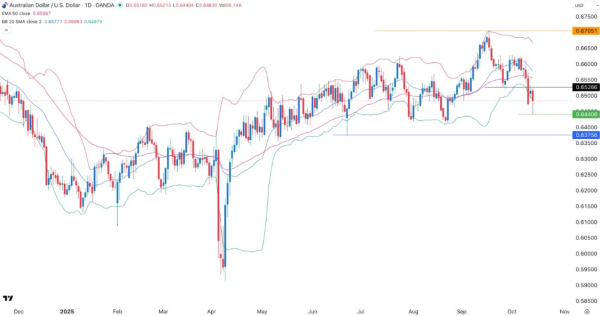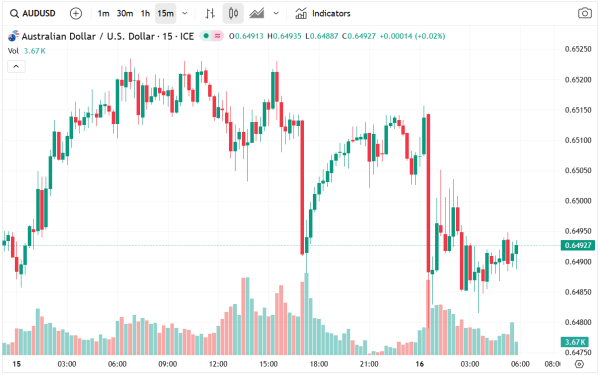The AUD/USD exchange rate has been under intense scrutiny in recent weeks as global market participants assess central bank signals and macroeconomic data. After a significant drop, the pair bounced back sharply, forming a hammer candlestick pattern, signaling a potential rebound. Ben Abrams, one of ProMorion Group’s brokers, offers an insightful look at the key aspects of this topic.
This movement comes in the wake of key updates from the Reserve Bank of Australia (RBA) and Federal Reserve Chair Jerome Powell, both of which have major implications for forex traders, investors, and analysts.
Federal Reserve and RBA Divergence
The recent decline in AUD/USD can be attributed to a combination of RBA minutes and Fed monetary policy signals. The RBA released the minutes of its latest meeting, confirming that officials opted to leave interest rates unchanged at 3.6%.
The minutes highlighted that the RBA remains data-dependent when considering rate cuts. Officials emphasized that the Australian labor market continues to perform strongly and that inflation is approaching the 2% target, with the unemployment rate at a historical low of 4%. These factors underpin the RBA’s cautious approach and signal that the Australian dollar (AUD) may retain support despite recent weakness.
In contrast, Jerome Powell, the Federal Reserve Chair, presented a more dovish outlook. Powell indicated that the Fed could continue cutting interest rates and slow down quantitative tightening, a program that reduced the bank’s balance sheet by trillions of dollars over recent years.
Powell stressed that the Fed is concerned by a “double-whammy” scenario: persistent inflation combined with rising unemployment. While the BLS has yet to release September’s jobs report, a private ADP survey indicated a loss of 36,000 jobs, signaling potential labor market softness.
Another critical factor is the ongoing US government shutdown, projected to reduce GDP by around $70 billion per week if extended. According to Polymarket polling data, most traders expect a resolution either later this month or in November. Such uncertainty adds downward pressure on the US dollar (USD) in the short term, indirectly supporting AUD/USD.
AUD/USD Recent Price Action
The AUD/USD daily chart reveals sustained pressure in recent weeks. The pair fell from a high of 0.6705 to a multi-month low of 0.6438, representing nearly a 4% drop since September’s peak.
During this period, AUD/USD has been trading between the lower and middle lines of the Bollinger Bands, reflecting heightened volatility and potential for reversals. Most notably, the formation of a hammer candlestick has caught the attention of technical analysts.
A hammer candle is characterized by a long lower shadow, a small real body, and typically little or no upper shadow. This formation often signals a potential reversal, suggesting that bullish pressure may be emerging after the recent sell-off. In this case, the hammer pattern points to a potential rebound for AUD/USD in the near term.
Key Levels to Watch
Traders analyzing AUD/USD should monitor critical technical levels closely. The next resistance level is identified at 0.6600, which aligns with prior consolidation zones and represents a potential target for bullish momentum.
Conversely, the hammer pattern becomes invalid if AUD/USD drops below its low at 0.6440. A breach of this level could signal further downside risk and potentially extend the ongoing bearish trend.
Additional technical indicators, such as Bollinger Bands, moving averages, and relative strength index (RSI), support the hammer’s bullish interpretation. The RSI, for example, has approached oversold conditions, which historically precede upward price corrections.
Upcoming Catalysts
The next significant driver for AUD/USD will be Australian jobs data, scheduled for release by the Australian Bureau of Statistics (ABS) on Thursday. Economists predict a slight rise in unemployment in September, a metric that could influence RBA expectations and trading sentiment.
Simultaneously, ongoing attention to US monetary policy remains crucial. Any further dovish signals from Jerome Powell or updates on quantitative tightening could continue to weigh on the USD, indirectly supporting the AUD/USD pair.
Conclusion
The AUD/USD exchange rate has experienced notable volatility, dropping to a multi-month low of 0.6438 before forming a hammer candlestick, signaling a potential rebound. Divergent policies between the RBA and the Federal Reserve, along with upcoming economic data releases, create both opportunities and risks for forex traders.
Technically, the hammer pattern suggests bullish momentum, with 0.6600 as the next resistance target and 0.6440 as the critical support level. Traders should closely monitor Australian labor market data, US economic indicators, and central bank commentary to adjust strategies and manage risk effectively.
For now, the AUD/USD hammer candle provides a strong signal that the recent downtrend may be losing steam, offering potential opportunities for those prepared to act on technical and fundamental cues.








